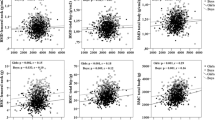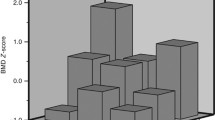Abstract
Summary
When compared, full-term prepubertal boys had greater regional bone size, higher total body (TB) bone mineral content (BMC), and regional bone density than preterm boys but higher TB bone content area and regional BMC than late-preterm boys. Implications include follow-up bone assessment and preterm formula feeding in late-preterm boys.
Introduction
This study was conducted to determine whether there are differences in bone mass and size among prepubertal boys born preterm (PT; ≤34 weeks gestation), late-preterm (LP; >34 and ≤37 weeks gestation), and at term (>37 weeks gestation) and to identify factors that are associated with bone mass and size in these children.
Methods
Total body (TB), spine and hip dual energy X-ray absorptiometry and tibia peripheral quantitative computed tomography measures were obtained on 24 boys aged 5.7 to 8.3 years.
Results
In multiple regression analysis adjusting for current weight, height, age, and jump power, term boys had greater cortical thickness (p = 0.03) and area (p = 0.01), higher trabecular volumetric bone mineral density (p = 0.05), TB bone mineral content (BMC; p = 0.007), and hip areal bone mineral density (aBMD; p = 0.01) than PT boys, and higher TB BMC (p = 0.01), TB bone area (p = 0.03), hip BMC (p = 0.02) and aBMD (p = 0.01), and femoral neck BMC (p = 0.05) and aBMD (p = 0.02) than LP boys. There were no differences in activity measures among gestation groups and no group-by-activity interactions.
Conclusion
Term boys have greater bone size and mass than PT boys and higher bone mass than LP boys at several bone sites. Activity measures did not differ among gestation groups and did not explain bone differences.
Similar content being viewed by others
References
Cooper C, Walker-Bone K, Adren N et al (2000) Novel insights into pathogenesis of osteoporosis: The role of intrauterine programming. Rheumatology 39:1312–1315
Godfrey K, Walker-Bone K, Robinson S et al (2001) Neonatal bone mass influence of parental birth weight, maternal smoking, body composition, and activity during pregnancy. J Bone Miner Res 16:1694–1703
American Academy of Pediatrics, American College of Obstetricians and Gynecologists (eds) (2002) Standard Terminology for Reporting of Reproductive Health Statistics in The United States. Elk Grove, IL, pp 377-394
Steichen J, Gralton L, Tsang C (1980) Osteopenia of prematurity. The cause and possible treatment. J Pediatr 96:528–534
Fewtrell M, Prentice A, Jones S et al (1999) Bone mineralization and turnover in preterm infants at 8–12 years of age: The effect of early diet. J Bone Miner Res 14:810–820
Kurl S, Heinonen K, Lamsimies E et al (1998) Determinants of bone mineral density in prematurely born children aged 6–7 years. Acta Paediatr 87:650–653
Schanler R, Burns P, Abrams S et al (1992) Bone mineralisation outcomes in human milk-fed preterm infants. Pediatr Res 31:583–586
Specker B, Johannsen N, Binkley T et al (2001) Total body bone mineral content and tibial cortical bone measures in preschool children. J Bone Miner Res 22:298–305
Backstrom M, Kuusela A-L, Koivisto A-M et al (2005) Bone structure and volumetric density in young adults born prematurely: a peripheral quantitative computed tomography study. Bone 36:688–693
Samra HA, Specker B (2007) Walking age does not explain term vs. preterm differences in bone geometry. J Pediatr 151:61–66
MacKelvie K, Khan K, McKay H (2002) Is there a critical period for bone response to weight-bearing exercise in children and adolescents? Br J Sports Med 36:250–257
Bass S, Pearce G, Bradney M et al (1998) Exercise before puberty may confer residual benefits in bone density in adulthood: studies in active prepubertal and retired female gymnasts. J Bone Miner Res 13:500–507
Fuchs R, Bauer J, Snow C (2001) Jumping improves hip and lumbar spine bone mass in prepubescent children: a randomized controlled trial. J Bone Miner Res 13:148–156
Goulding A, Cannan R, Williams S et al (1998) Bone mineral density in girls with forearm fractures. J Bone Miner Res 13:143–148
Davidoff M, Dias T, Damus K, Russell R, Bettegowda V, Dolan S et al (2006) Changes in the gestational age distribution among U.S. singleton births: impact on rates of late preterm birth, 1992 to 2000. Semin Perinatol 30:8–15
Hamilton B, Martin J, Ventura S. Births: Preliminary data for 2006 (2007) National Vital Statistics Reports (NVSR) 56(7)
Martin J, Hamilton B, Sutton P, et al. Births (2005) Final data for 2003. In: National vital statistics Reports. Hyattsville, MD: National Center for Health Statistics 1-116
Institute of Medicine (2006) Preterm birth: Causes, consequences, and prevention. Washington, DC
Engle W (2006) A recommendation for the definition of "Late Preterm" (Near-Term) and birthweight-gestational age classification system. Semin Perinatol 30:2–7
National Council on Radiation Protection and Measurement. Limitation of Exposure to Ionzing Radiation (1993). Bethesda, MD: National Council on Radiation Protection and Measurement Report No.: (NCRP#116)
Wilson P, Horwath C (1996) Validation of a short food frequency questionnaire for assessment of dietary calcium intake in women. Eur J Clin Nutr 50:220–228
Taylor R, Goulding A (1998) Short communication: validation of a short food frequency questionnaire to assess calcium intake in children aged 3 to 6 years. Eur J Clin Nutr 52:464–465
Montoye H, Kemper H, Saris W et al (1996) Measuring physical activity and energy expenditure. Champaign, IL
Svien R (2003) Health-Related fitness of Seven- to 10-year-old children with histories of preterm birth. Pediatr Phys Ther 15:74–83
Singhal A, Lucas A (2004) Early Origins of cardiovascular disease: Is there a unifying hypothesis? Lancet 363(9421):1642–1645
National Center for Health Statistics and the National Center for Disease Prevention and Health Promotion (2000) 2 to 20 years: Boys Body mass index-for-age percentiles [cited 2009 January 03]. Available from: http://www.cdc.gov/growthcharts
Bradney M, Pearce G, Naughton G et al (1998) Moderate exercise during growth in prepubertal boys: changes in bone mass, size, volumetric density, and bone strength: a controlled prospective study. J Bone Miner Res 13:1814–1821
McKay H, Mirwald R, Bailey D (2000) A 7-year longitudinal study comparison of peak bone mineral, peak lean, and peak fat mass accrual velocities and peak height velocity. Calcif Tissue Int (Suppl. 1):S58
Daly R, Saxon L, Turner C et al (2004) The relationship between muscle size and bone geometry during growth and in response to exercise. Bone 34:281–287
Ruff C (2003) Growth in bone strength, body size, and muscle size in a juvenile longitudinal sample. Bone 33:317–329
Lorentzon M, Mellstrom D, Ohlsson C (2005) Association of amount of physical activity with cortical bone size and trabecular volumetric BMD in young adult men: the GOOD Study. J Bone Miner Metab 20:1936–1943
Bishop N, King F, Lucas A (1993) Increased bone mineral content of preterm fed with nutrient enriched formula after discharge from hospital. Arch Dis Child 68:573–578
Lucas A, Bishop N, King J et al (1989) Randomized trial of nutrition for preterm infants after discharge. Arch Dis Child 64:1579–1586
Acknowledgment
This project was funded by the Ethel Austin Martin Endowed Program in Human Nutrition.
Conflicts of interest
None.
Author information
Authors and Affiliations
Corresponding author
Rights and permissions
About this article
Cite this article
Abou Samra, H., Stevens, D., Binkley, T. et al. Determinants of bone mass and size in 7-year-old former term, late-preterm, and preterm boys. Osteoporos Int 20, 1903–1910 (2009). https://doi.org/10.1007/s00198-009-0896-z
Received:
Accepted:
Published:
Issue Date:
DOI: https://doi.org/10.1007/s00198-009-0896-z




